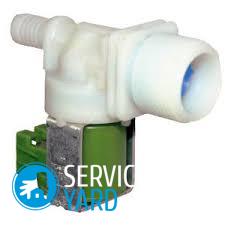Valve for washing machine for water

The solenoid valve is designed to supply water to the washing machine. At the inlet, a water supply hose is connected to it, and at the outlet it is connected to the fitting, with which water is in the hopper of the dispenser. How exactly does the valve for the washing machine for water work, what are the options for its device, how to check the working life of the device and repair it - all this you will learn from this article.
to contents ↑Principle of operation
The inlet valve for the washing machine is in two functional states: closed and open. The part is equipped with a coil, to which an electric current is supplied and an electromagnetic field is formed. As a result, it opens, and water gets into the washing machine.
When the tank is filled to the required level, a command is sent from the control module to shut off the power supply to the valve. As a result, it closes and water is no longer supplied.
to contents ↑Important! The valve for the washing machine for water has a throughput of 10-12 liters per minute.
Types of valves
The solenoid valve for the washing machine is distinguished by the number of sections. Water is supplied through each of them.
Design differences%
- The most common is the installation of a single-circuit intake damper. Water is simultaneously supplied to the drum and to other systems.
- For more functional units use two and three-section models.
Important! In general, the operation of all models of intake systems is the same. Voltage is applied to the electromagnetic coil, the plug is opened and water is supplied. After the power is stopped, the plug closes.
A bit about mechanics
Mechanical water supply systems are rarely used now. They were used for old washing machines in which there was no electronic control unit. In such valves there is only one circuit, for the opening of which there is a built-in mechanical actuator. In order to close it, the device has a shutter.
to contents ↑Important! The mechanical valve for the washing machine for water is very simple: there are no control elements, there is only a spring. Such systems broke very rarely.
We check the work
To check the valve for the washing machine for water, it is dismantled, connected to the inlet hose and, in turn, supply voltage to the coils. If it is serviceable, it opens, and when the power disappears, it closes tightly.
In addition to the general functionality, individual elements of the device are also subject to maintenance, especially if certain malfunctions and defects in the operation of the washing machine are noticed:
- Checked valve mesh. When the net becomes clogged, water stops flowing. The mesh is removed, cleaned and installed again.
Important! Such a malfunction is signaled by a lack of fluid collection or a very slow typing rate.
- In the event that the intake system did not open, the coil must have burnt out. For its verification, resistance is measured, the indicators of which should be at the level of 2-4 kOhm.
- If the shutter normally opens, but after the power is turned off, water leakage continues, this indicates a loss of flexibility by the membrane or a weakening of the stem spring.
Important! In this case, replacement of the spare part is required, since after reinstalling it, water will still leak.
- Checking is also required for pressed-in plastic inserts in the fittings. Most often they are used on the fitting through which water enters the compartment with rinse aid. If the insert falls out, water begins to overfill the compartment. A damaged valve for the washing machine must be replaced.
Valve repair
Usually such a part is not repaired, but is immediately replaced. It is possible to replace a burnt coil with a similar one. But experts recommend not doing this, as efforts may remain unjustified.
to contents ↑Valve replacement
If you need to replace the water supply valve for the washing machine, it is enough to follow the instructions below:
- Find the location of the intake valve. Most often, this is the top of the washer, but if the load is vertical, it is placed below.
- The washing machine is de-energized. The water supply is shut off, the inlet hose is disconnected.
- The top cover is removed. To do this, the screws located on the back are unscrewed, the lid is slid and removed. If the machine is loaded vertically, the side wall is removed.
- All wires and hoses are disconnected from the broken element. For hose fasteners use clamps that can be used repeatedly.
Important! Sometimes disposable clamps are installed, then you need to think about new ones for replacement in advance.
- To disconnect the valve from the body, unscrew the fixing bolts or bend the latches.
- The old part is rotated and pulled out.
- Install the new spare part in the reverse order.
- Performance is checked, washing starts.
to contents ↑Important! Be sure to remember how the hoses and wires were located. Even better - when disassembling, photograph them.
Stock footage
It is difficult to imagine a modern apartment without a washing machine. Its presence greatly facilitates life and saves time. The main thing is to monitor her condition and she will delight more than one year.
- How to choose a vacuum cleaner taking into account the characteristics of the house and coatings?
- What to look for when choosing a water delivery
- How to quickly create comfort at home - tips for housewives
- How to choose the perfect TV - useful tips
- What to look for when choosing blinds
- What should be running shoes?
- What useful things can you buy in a hardware store
- Iphone 11 pro max review
- Than iPhone is better than Android smartphones



